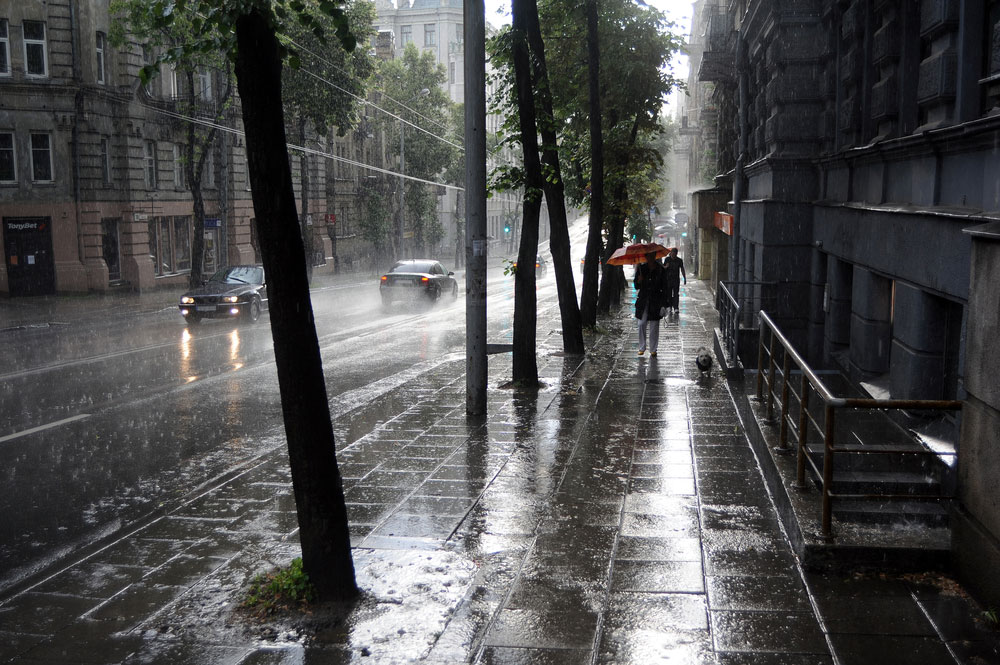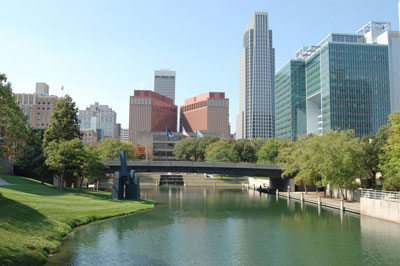Around the Water Cooler: Keeping Stormwater In Place
By Lahne Mattas-Curry
In the first post of my series on EPA water research, I gave a little history lesson and introduced green infrastructure. This week, we’re going to focus on the cost of combined sewer systems—to our health, our environment and even our economy.
There are hundreds of cities across the country that have combined sewer systems. For example, in New York City, more than 27 billion gallons of raw sewage and polluted stormwater discharge out of 460 combined sewer overflows into the New York Harbor alone each year. Think about all the impermeable surfaces in the city: sidewalks, streets, roofs, patios. It’s a concrete jungle.
To manage stormwater—and set up scenarios to see the impact of development—EPA scientists are developing the Stormwater Calculator that estimates the annual amount of stormwater runoff from a specific site and provides city planners, developers, and property owners a way to calculate the result of specific actions on our waterways. The online tool will be available later this fall.
As stormwater flows over the surface of your property, driveways, parking lots, roofs, etc, it picks up lots of sediments, such as animal droppings, tire residue, motor oil, brake dust, deicing compounds (in the winter), fertilizers, pesticides, trash, heavy metals and other pollutants and carries them to the nearest storm drain.
Obviously, there are things that cities can do to help reduce stormwater run off, and the steep price tag that goes with the cost of separating the combined sewer systems.
For example, in Omaha, the city is testing green infrastructure throughout the city to help reduce the $1.7 billion sewer system separation project. EPA scientists are testing and monitoring soils in Omaha, and other cities such as Cleveland and Cincinnati, to measure how successful green infrastructure is at keeping the combined sewer overflows to a minimum.
There are steps you can take too.
According to the University of Nebraska, for every 1,000 square feet of impermeable surface on your property, every 1 inch of rainfall generates approximately 626 gallons of water. If you add two 55 gallon rain barrels to your property, you now have water to irrigate your gardens. Add a rain garden, and you probably take care of much of the excess. Now, rain is absorbed back into our aquifers instead of rushing into the nearest storm drain, keeping waterways clean and ecosystems functioning.
Many states and counties subsidize the installation of green infrastructure on property, so check with your county and state government. It’s worth it to make sure we have clean water for generations to come.
About the Author: Known around the office as “AguaGirl,” Lahne Mattas-Curry works with EPA’s Safe and Sustainable Water Resources team and communicates water research to anyone who will listen or read her blog posts.
Editor's Note: The opinions expressed in Greenversations are those of the author. They do not reflect EPA policy, endorsement, or action, and EPA does not verify the accuracy or science of the contents of the blog.



Stormwater runoff is a huge problem for urban streams that are in areas with separate storm sewers too. Retention is not just for combined sewer systems.
HI Brian – Great point and stay tuned for next week’s post – it will be about urban streams, specifically buried streams and daylighting. Hope you enjoy the new water science focused series.
Lahne
Green Electricity : Rainbarrel And Turbine.-
Sometimes hurricanes and storms have resulted lost power in several thousands or millions home. With rainbarrel and turbine at the place, stormwater could be help to create green electricity…..
THANK YOU LAHNE FOR FOCUSING ON WATER RESEARCH ‘NOW’. YOUR PRO-ACTIVE THINKING MAY HELP WAKE UP A SOCIETY THAT HAS BECOME SO REACTIVE, THAT SOME DAY, JUST MAYBE PEOPLE WILL SEE THE VALUE OF TIME, EFFORT AND MONEY SPENT IN TAKING MEASURES LIKE THE ‘RAIN BARREL’ ONE IS THE BEST THING THEY CAN DO FOR GENERATIONS TO COME!
I MAY WRITE YOU AGAIN TO HELP ME WITH HOW TO GET MY LOCAL, COUNTY AND STATE OFFICIALS TO GET INVOLVED WITH A STORMWATER DRAINAGE SYSTEM BELONGING TO A MALL NEXT TO 10.2 ACRES MY FAMILY OWNS. IT IS THE ONLY UNDEVELOPED PROPERTY IN THE MIDDLE OF 5 MALLS AND NOW IS CALLED ‘CAUCCCI CANAL’ SINCE THE MALLS FAILED DRAINAGE SYSTEM IS MANAGED BY PUMPING THEIR OVERFLOWING BASINS ONTO OUR PROPERTY IN THE WEE HOURS OF THE MORNING. 20 YRS AGO, 4.6 OF THE PROPERTY WAS CONSIDERED COMMERCIAL & VERY VALUABLE. TODAY, THERE IS LESS THAN AN ACRE THAT IS BUILDABLE AND ALL THE ACRES IF SITTING, STAGNANT & POLLUTED WATER WILL PERCULATE DOWN INTO THE COHANSEY AQUAFIER THAT SERVICES EVERYONE SOUTH OF THAT PROPERTY. I’VE BEEN FIGHTING CITY HALL FOR 3 YRS NOW, BUT THE DEVELOPER WHO CAUSED THIS SITUATION, IS PLANNING ANOTHER MALL IN THE VERY SAME AREA AND THE TWP OFFICIALS WANT ANOTHER RATEABLE. THIS IS A PRIME EXAMPLE OF POOR PLANNING AND SHALLOW PRIORITIES. I’LL KEEP YOU POSTED IF YOU LIKE AS I’M PLANNING ON BLOWING THE WHISTLE TO THE EPA’S COMPLIANCE AND VIOLATIONS AGENCY.